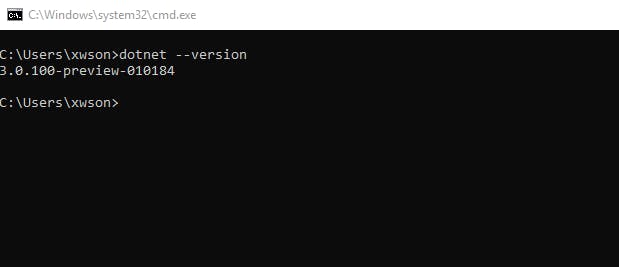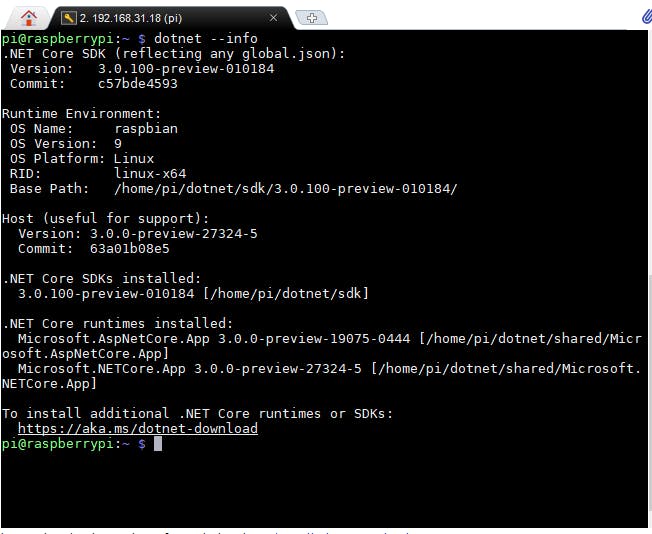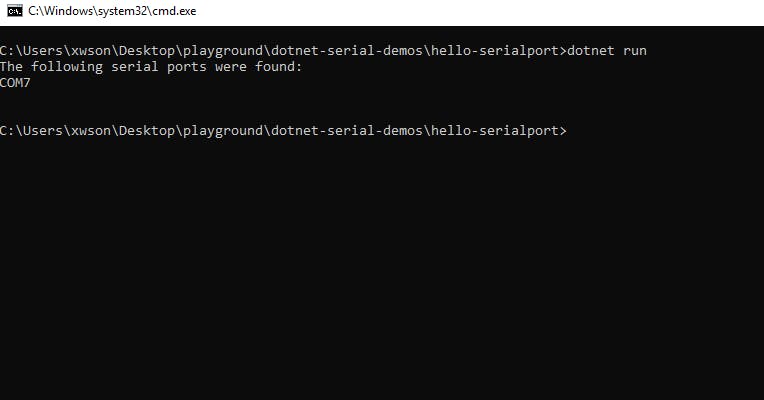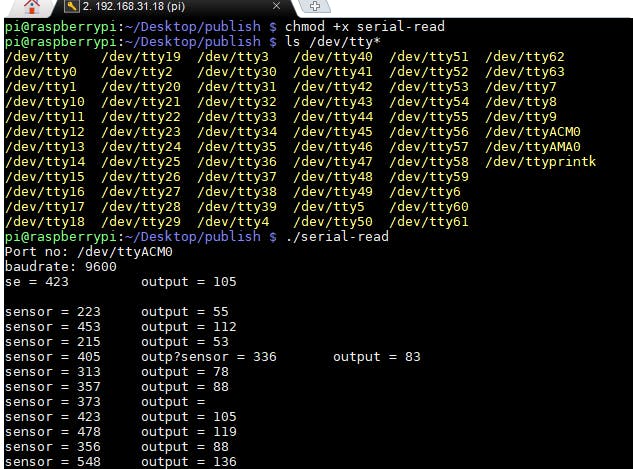資料介紹
描述
描述
.NET Core 3.0 剛剛在 2019 年 1 月發(fā)布了預(yù)覽版。正如微軟在他們的文檔中所說,Linux 現(xiàn)在支持 System.IO.Ports.SerialPort。我迫不及待地想用它弄臟我的手。在本文中,我將向您展示如何使用 System.IO.Ports.SerialPort 進(jìn)行串行讀/寫,以及如何在 Windows 上構(gòu)建源代碼并在 linux-arm (Raspbian) 上運(yùn)行二進(jìn)制文件。
筆記
- 在我寫這篇文章的時候,.NET Core和System.IO.Ports已經(jīng)處于預(yù)覽階段,當(dāng)你閱讀這篇文章時,請檢查是否有任何新版本。使用最新的穩(wěn)定版本運(yùn)行您的代碼。
- 我在 Windows 10 上構(gòu)建和測試本文的代碼,并在 Raspberry Pi Raspbian 中運(yùn)行它們。如果您使用 Mac/Linux 作為開發(fā)機(jī)器,SerialPort 庫也應(yīng)該可以工作。
開發(fā)設(shè)置
1. 在您的開發(fā)機(jī)器上下載并安裝.NET Core 3.0 SDK(非運(yùn)行時)。安裝后,打開終端,輸入dotnet --version. 您應(yīng)該會看到像 3.0.x 這樣的 dotnet 版本。

2. 安裝Visual Studio Code作為 C# 代碼編輯器。然后安裝C# 擴(kuò)展。
3. 在樹莓派上安裝.NET Core。如果你想在開發(fā)機(jī)器上構(gòu)建 C# 代碼并在 PI 上運(yùn)行二進(jìn)制文件,你只需要安裝.NET Runtime. 如果要在 PI 上構(gòu)建和運(yùn)行源代碼,則需要安裝.NET SDK其中還包括 .Net Runtime。請注意,您應(yīng)該linux arm32為您的 PI 使用構(gòu)建。為簡單起見,我將向您展示如何在 PI 上安裝 .NET Core SDK:
# in raspberry pi terminal
sudo apt-get update
# install .net core dependencies
sudo apt-get install curl libunwind8 gettext
cd ~
# download .net core 3.0
wget
mkdir -p $HOME/dotnet && tar vzxf dotnet-sdk-3.0.100-preview-010184-linux-arm.tar.gz -C $HOME/dotnet
echo "export PATH=$PATH:$HOME/dotnet" >> ~/.bashrc
echo "export DOTNET_ROOT=$HOME/dotnet" >> ~/.bashrc
export PATH=$PATH:$HOME/dotnet
export DOTNET_ROOT=$HOME/dotnet
安裝后,使用 dotnet --info 進(jìn)行驗證。你應(yīng)該看到這樣的安裝信息:

4. 準(zhǔn)備任何啟用串行功能的設(shè)備以接收和發(fā)送串行消息。對我來說,這是一個 Arduino Uno。
你好串行端口
設(shè)置好開發(fā)工具后,讓我們從一個簡單的 C# 項目開始我們的旅程,該項目將打印所有可用的串行端口。
在您的開發(fā)機(jī)器上,使用以下命令啟動一個 dotnet 項目:
mkdir hello-serialport && cd hello-serialport
dotnet new console
dotnet add package System.IO.Ports --version 4.6.0-preview.19073.11
打開program.cs文件,將內(nèi)容替換為以下代碼:
using System;
using System.IO.Ports;
namespace hello_serialport
{
class Program {
static void Main(string[] args) { // Get a list of serial port names. string[] ports = SerialPort.GetPortNames(); Console.WriteLine("The following serial ports were found:"); // Display each port name to the console. foreach(string port in ports) { Console.WriteLine(port); } Console.ReadLine(); } }}
鍵入dotnet run以在開發(fā)機(jī)器上運(yùn)行代碼。

要為 RPi 構(gòu)建項目,請運(yùn)行:
dotnet publish -r linux-arm --self-contained false
然后轉(zhuǎn)到{your_project_root}\bin\Debug\netcoreapp3.0\linux-arm,將文件夾復(fù)制publish 到您的 PI。在 Pi 上,轉(zhuǎn)到發(fā)布文件夾,運(yùn)行:
chmod +x hello-serialport
./hello-serialport
您的 hello-serialport 正在 Rapsberry Pi 上運(yùn)行!

.NET Core 應(yīng)用程序部署
在 hello serialport 項目中,我們在 windows 上進(jìn)行開發(fā),構(gòu)建 linux-arm 二進(jìn)制文件,然后在 raspberry pi 上運(yùn)行二進(jìn)制文件。根據(jù)微軟的文檔,我們剛剛制作了一個依賴于框架的可執(zhí)行文件(FDE),這意味著該可執(zhí)行文件只能在安裝了正確版本的 .NET Core Runtime 的樹莓派上運(yùn)行。
您可以通過參考以下文檔來玩不同類型的部署:
串行讀取
打開 Arduino IDE,轉(zhuǎn)到 File-->Examples-->03.Analog-->AnalogInOutSerial 并將其上傳到 Arduino。在此處粘貼代碼:
/*
Analog input, analog output, serial output
Reads an analog input pin, maps the result to a range from 0 to 255 and uses
the result to set the pulse width modulation (PWM) of an output pin.
Also prints the results to the Serial Monitor.
The circuit:
- potentiometer connected to analog pin 0.
Center pin of the potentiometer goes to the analog pin.
side pins of the potentiometer go to +5V and ground
- LED connected from digital pin 9 to ground
created 29 Dec. 2008
modified 9 Apr 2012
by Tom Igoe
This example code is in the public domain.
http://www.arduino.cc/en/Tutorial/AnalogInOutSerial
*/
const int analogInPin = A0; // Analog input pin that the potentiometer is attached to
const int analogOutPin = 9; // Analog output pin that the LED is attached to
int sensorValue = 0; // value read from the pot
int outputValue = 0; // value output to the PWM (analog out)
void setup() {
// initialize serial communications at 9600 bps:
Serial.begin(9600);
}
void loop() {
// read the analog in value:
sensorValue = analogRead(analogInPin);
// map it to the range of the analog out:
outputValue = map(sensorValue, 0, 1023, 0, 255);
// change the analog out value:
analogWrite(analogOutPin, outputValue);
// print the results to the Serial Monitor:
Serial.print("sensor = ");
Serial.print(sensorValue);
Serial.print("\t output = ");
Serial.println(outputValue);
// wait 2 milliseconds before the next loop for the analog-to-digital
// converter to settle after the last reading:
delay(2);
}
該程序不斷發(fā)出模擬引腳的讀數(shù)。讓我們編寫一個 C# 程序來讀取消息:
using System;
using System.IO.Ports;
namespace serial_read
{
class Program
{
static SerialPort _serialPort;
static void Main(string[] args)
{
Console.Write("Port no: ");
string port = Console.ReadLine();
Console.Write("baudrate: ");
string baudrate = Console.ReadLine();
// Create a new SerialPort on port COM7
_serialPort = new SerialPort(port, int.Parse(baudrate));
// Set the read/write timeouts
_serialPort.ReadTimeout = 1500;
_serialPort.WriteTimeout = 1500;
_serialPort.Open();
while (true)
{
Read();
}
_serialPort.Close();
}
public static void Read()
{
try
{
string message = _serialPort.ReadLine();
Console.WriteLine(message);
}
catch (TimeoutException) { }
}
}
}
在 Raspberry Pi 上構(gòu)建并運(yùn)行:

值得一提的是 SerialPort.ReadLine() 是一種阻塞方法。如果您不希望主線程被阻塞,請使用多線程。
請參考微軟提供的例子來學(xué)習(xí)如何進(jìn)行串行寫入和多線程。系列活動也是值得探索的好東西。
進(jìn)一步的工作
- ASP.NET Core 從 .NET Core v1 開始可用。通過結(jié)合 SerialPort API 和 ASP.NET,我們可以構(gòu)建一個 Web UI 來控制一些設(shè)備,比如移動機(jī)器人。
- Microsoft 開源了WPF和WinForms ,它們都將從 .NET Core 3.0 開始提供。有一天,我們可以安全地將舊的 Windows 桌面串行應(yīng)用程序移植到所有平臺,甚至可以在 Raspberry Pi 上編寫一個 winForm 串行通信應(yīng)用程序!
參考
[1] 在 Raspberry Pi 上安裝 .NET Core 2.x SDK 并使用 System.Device.Gpio 閃爍 LED。
- MegaRAID CacheCade Pro 2.0讀/寫緩存軟件
- STM32學(xué)習(xí)筆記一、 IO模擬串行通訊
- PIC何謂讀-修改-寫,導(dǎo)致的問題及其解決之道
- 單片機(jī)IO口操作總結(jié)
- 具有讀/寫遙測功能的μ模塊調(diào)節(jié)器
- PIC16系列單片機(jī)的ID碼的讀和寫資料下載
- 51單片機(jī)進(jìn)行串行接收并顯示的程序免費(fèi)下載
- 使用51單片機(jī)普通IO口模擬IIC總線的程序?qū)崿F(xiàn)資料免費(fèi)下載
- 如何使用寄存器級讀&寫控制基于PXI平臺的FPGA 12次下載
- 如何使用寄存器級讀&寫控制基于PXI平臺的FPGA 14次下載
- 使用寄存器級讀&寫控制基于PXI平臺的FPGA 10次下載
- SerialPort主要用在通信上 6次下載
- C語言教程之讀/寫BIOS計時器 0次下載
- 電池管理器件的讀/寫操作
- DDR 1&2&3的“讀”和“寫”眼圖分析
- 初識IO-Link及IO-Link設(shè)備軟件協(xié)議棧 3126次閱讀
- 嵌入式eMMC存儲讀干擾應(yīng)對方案 825次閱讀
- 如何對MAX22000可配置模擬IO進(jìn)行編程 1018次閱讀
- 使用STM32F10xxx SWJ引腳作為標(biāo)準(zhǔn)IO 2270次閱讀
- 淺談串行 EEPROM 的讀/寫應(yīng)用程序 2226次閱讀
- NXP MFRC523高集成讀/寫器的主要特性及應(yīng)用 3928次閱讀
- 數(shù)字溫度傳感器系統(tǒng)中每種串行總線的優(yōu)缺點(diǎn)介紹 1536次閱讀
- 讀、寫、擦除是SSD對NAND的三大基本操作 9916次閱讀
- 如何把二進(jìn)制轉(zhuǎn)換為格雷碼?格雷碼是如何判斷讀空寫滿呢? 8120次閱讀
- 如何解決異步FIFO跨時鐘域亞穩(wěn)態(tài)問題? 5886次閱讀
- Linux下flash操作讀、寫、擦除步驟 1.4w次閱讀
- STM8S利用STVP方式進(jìn)行IO復(fù)用分析 2099次閱讀
- 通過對blktrace的輸出結(jié)果進(jìn)行分析讀、寫操作的磁盤塊進(jìn)行I/O頻次統(tǒng)計 9328次閱讀
- System generator如何與MATLAB進(jìn)行匹配? 7526次閱讀
- System Generator實(shí)現(xiàn)串口通信(一行HDL代碼都不用寫) 2831次閱讀
下載排行
本周
- 1山景DSP芯片AP8248A2數(shù)據(jù)手冊
- 1.06 MB | 532次下載 | 免費(fèi)
- 2RK3399完整板原理圖(支持平板,盒子VR)
- 3.28 MB | 339次下載 | 免費(fèi)
- 3TC358743XBG評估板參考手冊
- 1.36 MB | 330次下載 | 免費(fèi)
- 4DFM軟件使用教程
- 0.84 MB | 295次下載 | 免費(fèi)
- 5元宇宙深度解析—未來的未來-風(fēng)口還是泡沫
- 6.40 MB | 227次下載 | 免費(fèi)
- 6迪文DGUS開發(fā)指南
- 31.67 MB | 194次下載 | 免費(fèi)
- 7元宇宙底層硬件系列報告
- 13.42 MB | 182次下載 | 免費(fèi)
- 8FP5207XR-G1中文應(yīng)用手冊
- 1.09 MB | 178次下載 | 免費(fèi)
本月
- 1OrCAD10.5下載OrCAD10.5中文版軟件
- 0.00 MB | 234315次下載 | 免費(fèi)
- 2555集成電路應(yīng)用800例(新編版)
- 0.00 MB | 33566次下載 | 免費(fèi)
- 3接口電路圖大全
- 未知 | 30323次下載 | 免費(fèi)
- 4開關(guān)電源設(shè)計實(shí)例指南
- 未知 | 21549次下載 | 免費(fèi)
- 5電氣工程師手冊免費(fèi)下載(新編第二版pdf電子書)
- 0.00 MB | 15349次下載 | 免費(fèi)
- 6數(shù)字電路基礎(chǔ)pdf(下載)
- 未知 | 13750次下載 | 免費(fèi)
- 7電子制作實(shí)例集錦 下載
- 未知 | 8113次下載 | 免費(fèi)
- 8《LED驅(qū)動電路設(shè)計》 溫德爾著
- 0.00 MB | 6656次下載 | 免費(fèi)
總榜
- 1matlab軟件下載入口
- 未知 | 935054次下載 | 免費(fèi)
- 2protel99se軟件下載(可英文版轉(zhuǎn)中文版)
- 78.1 MB | 537798次下載 | 免費(fèi)
- 3MATLAB 7.1 下載 (含軟件介紹)
- 未知 | 420027次下載 | 免費(fèi)
- 4OrCAD10.5下載OrCAD10.5中文版軟件
- 0.00 MB | 234315次下載 | 免費(fèi)
- 5Altium DXP2002下載入口
- 未知 | 233046次下載 | 免費(fèi)
- 6電路仿真軟件multisim 10.0免費(fèi)下載
- 340992 | 191187次下載 | 免費(fèi)
- 7十天學(xué)會AVR單片機(jī)與C語言視頻教程 下載
- 158M | 183279次下載 | 免費(fèi)
- 8proe5.0野火版下載(中文版免費(fèi)下載)
- 未知 | 138040次下載 | 免費(fèi)
 電子發(fā)燒友App
電子發(fā)燒友App

















 創(chuàng)作
創(chuàng)作 發(fā)文章
發(fā)文章 發(fā)帖
發(fā)帖  提問
提問  發(fā)資料
發(fā)資料 發(fā)視頻
發(fā)視頻 上傳資料賺積分
上傳資料賺積分









評論